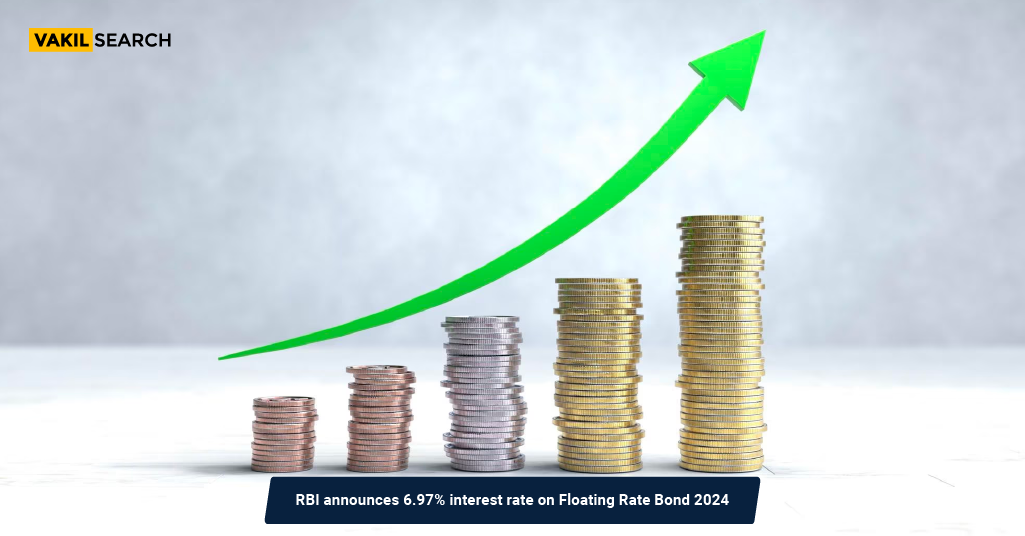The Reserve Bank of India (RBI) has announced a competitive interest rate of 6.97% on the Floating Rate Bond for the year 2024. This announcement provides investors with an attractive investment opportunity, as the interest rate is subject to periodic revisions based on prevailing market conditions. The Floating Rate Bond offers flexibility and potential for higher returns, making it an appealing option for those seeking investment avenues with adjustable interest rates.
Introduction: RBI’s Announcement on Floating Rate Bond 2024
On 4 May 2023, the Reserve Bank of India (RBI) announced a 6.97% interest rate on the Government of India’s Floating Rate Bond 2024 (FRB 2024) for the half year 7 May 2023 to 6 November 2023.
Overview of the Floating Rate Bond Scheme
Bonds typically have a predetermined coupon or interest rate. For example, you can purchase a Rs 10,000 bond with a 5% coupon rate. The bond issuer will pay you Rs 500 in annual interest in the case of such a bond. This interest is constant and does not change in response to the market’s current interest rate.
A floating rate bond, on the other hand, is a debt instrument that does not have a set coupon rate and whose interest rate fluctuates based on the benchmark against which the bond is drawn. Benchmarks are market tools that have an impact on the economy as a whole. Repo rate or reverse repo rate, for example, can be used as benchmarks for a floating rate bond.
Key Features of the Floating Rate Bond 2024
The interest rate on the FRB 2024 shall be reset at the average rate (rounded off to two decimal places) of the implicit yields at the cut-off prices of the last three auctions of Government of India 182-day Treasury Bills held up to the coupon reset date, which is May 07, 2023. The implicit yields will be estimated by taking into account all 365 days in a year.
Explanation of the 6.97% Interest Rate
The FRB bonds have a coupon with a base rate equal to the weighted average yield of the last three auctions of 182-day Treasury Bills (T-Bill), plus an auction-determined fixed spread.
Comparison with Previous Interest Rates on Floating Rate Bonds
The floating rate bond’s interest rate is linked to a benchmark rate (there is a fixed and variable component). It varies in response to changes in the benchmark rate. Hence comparisons cannot be drawn as the change does not depend on the previous bond rate but the benchmark.
Factors Influencing the Interest Rate Decision
Bond yields, like other everything in the secondary market, are determined by supply and demand equilibrium. Bond yields are inversely related to bond prices. For example, suppose you have a 5-year bond with a 5% coupon rate and a face value of Rs 10,000. The bond will pay you Rs 500 in interest every year. If interest rates in the market rise over 5%, investors will abandon your bonds in favour of new ones with greater interest rates.
As a result, you will have to cut the price of your bond in order to enhance its yield. When the price is reduced, the coupon rate rises due to the lower face value, boosting the bond’s yield.
Implications for Investors and Bondholders
Protection Against Rising Interest Rates: Floating rate bonds can provide protection against rising interest rates because their coupon payments adjust with changes in the reference rate. As interest rates increase, the coupon payments on floating-rate bonds also increase, preserving the bond’s value.
Income Stability: For income-oriented investors, floating-rate bonds can offer a more stable income stream compared to fixed-rate bonds. Since coupon payments adjust periodically, the income generated by floating-rate bonds can keep pace with changes in prevailing interest rates.
Diversification: Including floating rate bonds in an investment portfolio can add diversification benefits. These bonds typically have a lower duration (a measure of interest rate sensitivity) compared to fixed-rate bonds. As a result, the performance of floating-rate bonds may be less affected by changes in interest rates.
Potential Benefits of Investing in Floating Rate Bonds
- Floating rate bonds can be attractive during periods of rising interest rates since their coupon payments increase accordingly. This helps mitigate the risk of declining bond prices that typically occurs with fixed-rate bonds when interest rates rise.
- Floating rate bonds can provide a level of income preservation, as the coupon payments adjust to reflect changes in prevailing interest rates. This feature can be beneficial for income-focused investors seeking stable income streams.
- Floating rate bonds are often issued by well-established entities and traded in liquid markets. This liquidity can make it easier for investors to buy and sell these bonds at fair prices, enhancing portfolio flexibility.
Risks and Considerations for Investors
- Floating-rate bonds often offer lower yields compared to fixed-rate bonds of similar credit quality and maturity. Investors seeking higher income may find the coupon payments of floating-rate bonds less attractive, especially during periods of low interest rates.
- The creditworthiness of the issuer remains an important consideration when investing in floating-rate bonds. Investors should assess the credit quality of the issuer to gauge the risk of default or downgrade. Lower-rated issuers may offer higher yields but also carry higher credit risk.
- While floating-rate bonds offer protection against rising interest rates, they may have limited upside potential during periods of declining interest rates. This is because the coupon payments may decrease when the reference rate falls, potentially leading to lower income for bondholders.
- Some floating rate bonds may have complex structures, such as caps, floors, or interest rate resets based on specific formulas. Investors should thoroughly understand the terms and conditions of the bonds they invest in to assess the associated risks and potential returns.
Also, Read:










